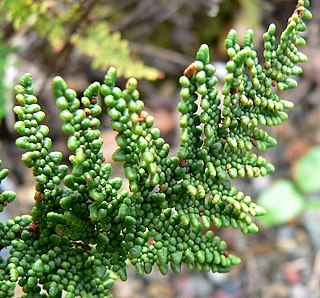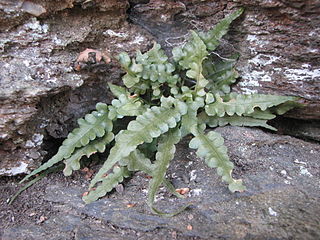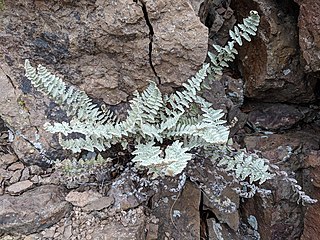
Asplenium platyneuron, commonly known as ebony spleenwort or brownstem spleenwort, is a fern native to North America east of the Rocky Mountains. It takes its common name from its dark, reddish-brown, glossy stipe and rachis, which support a once-divided, pinnate leaf. The fertile fronds, which die off in the winter, are darker green and stand upright, while the sterile fronds are evergreen and lie flat on the ground. An auricle at the base of each pinna points towards the tip of the frond. The dimorphic fronds and alternate, rather than opposite, pinnae distinguish it from the similar black-stemmed spleenwort.

Asplenium rhizophyllum, the (American) walking fern, is a frequently-occurring fern native to North America. It is a close relative of Asplenium ruprechtii which is found in East Asia and also goes by the common name of "walking fern".

Myriopteris clevelandii, formerly known as Cheilanthes clevelandii, is a species of lip fern known by the common name Cleveland's lip fern. It is native to southern California and Baja California in Mexico. The leaf is divided into small, bead-like segments densely covered with scales beneath. In M. clevelandii, some of these scales are reduced to hairlike structures, which help distinguish it from the closely related M. covillei. It is usually found growing on exposed rock, particularly igneous rock.

Asplenium septentrionale is a species of fern known by the common names northern spleenwort and forked spleenwort. It is native to Europe, Asia and western North America, where it grows on rocks. Its long, slender leaves give it a distinctive appearance. Three subspecies exist, corresponding to a tetraploid and a diploid cytotype and their triploid hybrid.

Asplenium montanum, commonly known as the mountain spleenwort, is a small fern endemic to the eastern United States. It is found primarily in the Appalachian Mountains from Vermont to Alabama, with a few isolated populations in the Ozarks and in the Ohio Valley. It grows in small crevices in sandstone cliffs with highly acid soil, where it is usually the only vascular plant occupying that ecological niche. It can be recognized by its tufts of dark blue-green, highly divided leaves. The species was first described in 1810 by the botanist Carl Ludwig Willdenow. No subspecies have been described, although a discolored and highly dissected form was reported from the Shawangunk Mountains in 1974. Asplenium montanum is a diploid member of the "Appalachian Asplenium complex," a group of spleenwort species and hybrids which have formed by reticulate evolution. Members of the complex descended from A. montanum are among the few other vascular plants that can tolerate its typical habitat.

Asplenium pinnatifidum, commonly known as the lobed spleenwort or pinnatifid spleenwort, is a small fern found principally in the Appalachian Mountains and the Shawnee Hills, growing in rock crevices in moderately acid to subacid strata. Originally identified as a variety of walking fern, it was classified as a separate species by Thomas Nuttall in 1818. It is believed to have originated by chromosome doubling in a hybrid between walking fern and mountain spleenwort, producing a fertile tetraploid, a phenomenon known as alloploidy; however, the hypothesized parental hybrid has never been located. It is intermediate in morphology between the parent species: while its leaf blades are long and tapering like that of walking fern, the influence of mountain spleenwort means that the blades are lobed, rather than whole. A. pinnatifidum can itself form sterile hybrids with several other spleenworts.

Asplenium bradleyi, commonly known as Bradley's spleenwort or cliff spleenwort, is a rare epipetric fern of east-central North America. Named after Professor Frank Howe Bradley, who first collected it in Tennessee, it may be found infrequently throughout much of the Appalachian Mountains, the Ozarks, and the Ouachita Mountains, growing in small crevices on exposed sandstone cliffs. The species originated as a hybrid between mountain spleenwort and ebony spleenwort ; A. bradleyi originated when that sterile diploid hybrid underwent chromosome doubling to become a fertile tetraploid, a phenomenon known as allopolyploidy. Studies indicate that the present population of Bradley's spleenwort arose from several independent doublings of sterile diploid hybrids. A. bradleyi can also form sterile hybrids with several other spleenworts.

Asplenium × ebenoides is a hybrid fern native to eastern North America, part of the "Appalachian Asplenium complex" of related hybrids. The sterile offspring of the walking fern (A. rhizophyllum) and the ebony spleenwort (A. platyneuron), A. × ebenoides is intermediate in morphology between its two parents, combining the long, narrow blade of A. rhizophyllum with a dark stem and lobes or pinnae similar to those of A. platyneuron. While A. × ebenoides is generally sterile, fertile specimens with double the number of chromosomes are known from Havana Glen, Alabama. These fertile allotetraploids were reclassified as a separate species named A. tutwilerae in 2007, retaining the name A. × ebenoides for the sterile diploids only.

Asplenium tutwilerae is a rare epipetric fern found only in Hale County, Alabama, United States. A. tutwilerae is a fertile allotetraploid, formed by the chromosomal doubling of a specimen of the sterile diploid A. × ebenoides, a hybrid of A. platyneuron and A. rhizophyllum. Except for its spores, which are fertile rather than malformed, A. tutwilerae is essentially identical to A. × ebenoides and was described as part of that species until 2007. It is named in honor of Julia Tutwiler, who discovered the only known wild population at Havana Glen in 1873.
Asplenium × wherryi, known as Wherry's spleenwort, is a rare hybrid fern of the Appalachian Mountains. The sterile triploid offspring of mountain spleenwort (A. montanum) and Bradley's spleenwort (A. bradleyi), it is known from a few sites where those species grow together. First collected by Edgar T. Wherry in 1935, it was largely ignored until a new colony was found in 1961, and the species was named in his honor.
Asplenium × gravesii, commonly known as Graves' spleenwort, is a rare, sterile, hybrid fern, named for Edward Willis Graves (1882–1936). It is formed by the crossing of Bradley's spleenwort (A. bradleyi) with lobed spleenwort (A. pinnatifidum). It is only found where its parent species are both present; in practice, this proves to be a few scattered sites in the Appalachian Mountains, Shawnee Hills, and Ozarks, reaching perhaps its greatest local abundance around Natural Bridge State Resort Park. Like its parents, it prefers to grow in acid soil in the crevices of sandstone cliffs.
Asplenium × kentuckiense, commonly known as Kentucky spleenwort, is a rare, sterile, hybrid fern. It is formed by the crossing of lobed spleenwort (A. pinnatifidum) with ebony spleenwort (A. platyneuron). Found intermittently where the parent species grow together in the eastern United States, it typically grows on sandstone cliffs, but is known from other substrates as well.
Asplenium × boydstoniae, commonly known as Boydston's spleenwort, is a rare, sterile, hybrid fern. It is formed by the crossing of Tutwiler's spleenwort (A. tutwilerae) with ebony spleenwort (A. platyneuron). The hybrid was produced in culture in 1954. It was not discovered in the wild until 1971, when it was found by Kerry S. Walter at Havana Glen, Alabama, the only known wild site for Tutwiler's spleenwort. Walter named it for Kathryn E. Boydston, an expert in fern culture. Except for the tip of its leaf blade, it largely resembles its ebony spleenwort parent.
Asplenium arcanum is a fern known from western Mexico and Nicaragua.

Myriopteris alabamensis, the Alabama lip fern, is a moderately-sized fern of the United States and Mexico, a member of the family Pteridaceae. Unlike many members of its genus, its leaves have a few hairs on upper and lower surfaces, or lack them entirely. One of the cheilanthoid ferns, it was usually classified in the genus Cheilanthes as Cheilanthes alabamensis until 2013, when the genus Myriopteris was again recognized as separate from Cheilanthes. It typically grows in shade on limestone outcrops.
Myriopteris yatskievychiana is a small fern native to Mexico, a member of the family Pteridaceae. It is known only from a single collection in the Mexican state of Sonora. While superficially similar to golden lip fern, a widespread species in Mexico, differences in its coating of hairs and its small size make it distinctive. One of the cheilanthoid ferns, it was usually classified in the genus Cheilanthes until 2013, when the genus Myriopteris was again recognized as separate from Cheilanthes.

Argyrochosma peninsularis is a fern endemic to Baja California Sur. It grows in dry, rocky places. First described as a species in 1939, it was transferred to the new genus Argyrochosma in 1987, recognizing their distinctness from the "cloak ferns". A dusting of powdery material and the presence of occasional scales on the central axis of its leaves help distinguish it from related species.

Myriopteris aurea, the golden lip fern or Bonaire lip fern, is a moderately-sized fern native to the Americas, a member of the family Pteridaceae. Unlike many members of its genus, its leaf is only modestly dissected into lobed leaflets (pinnae), which are hairy both above and below. One of the cheilanthoid ferns, until 2013 it was classified in the genus Cheilanthes as Cheilanthes bonariensis, when the genus Myriopteris was again recognized as separate from Cheilanthes. It typically grows on dry, rocky slopes, and ranges from Mexico, where it is common and widespread, and the southwestern United States south and east through Central and South America as far as Chile and Argentina.

Argyrochosma microphylla, the small-leaf false cloak fern, is a species of fern native to New Mexico, Texas and northern Mexico. It grows on limestone rocks and cliffs, and has finely-divided leaves with small leaf segments, often folded in half when dry, which lack the white powder present on the leaf underside of many related species. First described as a species in 1869, it was transferred to the new genus Argyrochosma in 1987, recognizing their distinctness from the "cloak ferns".

Myriopteris rufa, commonly known as Eaton's lip fern, is a moderately-sized fern of Mexico and the southwestern United States, with outlying populations in Costa Rica and the Appalachian Mountains. One of the cheilanthoid ferns, it was usually classified in the genus Cheilanthes, as Cheilanthes eatonii, until 2013, when the genus Myriopteris was again recognized as separate from Cheilanthes. It typically grows in rocky habitats, most frequently on limestone but also sometimes on basalt or shale.
















